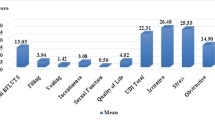Abstract
Introduction and hypothesis
We aimed to compare the incidence of urinary incontinence in women with Marfan syndrome and controls, hypothesizing that connective tissue abnormality could contribute to urinary incontinence.
Methods
A cross-sectional historical cohort study was conducted on 14 premenopausal women with Marfan syndrome and 534 controls using Urogenital Distress Inventory Short Form and Incontinence Impact Questionnaire Short Form.
Results
Marfan subjects had significantly higher incidence of urinary symptoms, stress urinary incontinence (SUI) and urge urinary incontinence (UUI) than controls (P = 0.02, P = 0.03, P = 0.02), despite their lower parity (P = 0.01). Direct logistic regression analysis indicated that Marfan syndrome, parity and age were associated with SUI; while Marfan syndrome was the only significant predictor of UUI.
Conclusions
Premenopausal women with Marfan syndrome had a higher incidence of reported urinary symptoms. Urinary incontinence should be added to the list of clinical manifestations in women with Marfan syndrome.
Similar content being viewed by others
References
Ulmsten U, Ekman G, Giertz G, Malmstrom A (1987) Different biochemical composition of connective tissue in continent and stress incontinent women. Acta Obstet Gynecol Scand 66:455–457
Falconer C, Ekman G, Malmstrom A, Ulmsten U (1994) Decreased collagen synthesis in stress-incontinent women. Obstet Gynecol 84:583–586
Keane DP, Sims TJ, Abrams P, Bailey FJ (1997) Analysis of collagen status in premenopausal nulliparous women with genuine stress incontinence. Br J Obstet Gynaecol 104:994–998
Song Y, Hong X, Yu Y, Lin Y (2007) Changes of collagen type III and decorin in paraurethral connective tissue from women with stress urinary incontinence and prolapse. Int Urogynecol J Pelvic Floor Dysfunct 18:1459–1463
Pyeritz RE, McKusick VA (1979) The Marfan syndrome: diagnosis and management. N Engl J Med 300:772–777
Dietz HC, Cutting GR, Pyeritz RE et al (1991) Marfan syndrome caused by a recurrent de novo missense mutation in the fibrillin gene. Nature 352:337–339
Callewaert B, Malfait F, Loeys B, De Paepe A (2008) Ehlers–Danlos syndromes and Marfan syndrome. Best Pract & Res Clin Rheumatology 22:165–189
Carley ME, Schaffer J (2000) Urinary incontinence and pelvic organ prolapse in women with Marfan or Ehlers–Danlos syndrome. Am J Obstet Gynecol 182:1021–1023
Pang MW, Leung HY, Chan LW, Yip SK (2005) The impact of urinary incontinency on quality of life among women in Hong Kong. HKMJ 11:158–163
Uebersax JS, Wyman JF, Shumaker SA, McClish DK, Fantl JA (1995) Short forms to assess life quality and symptom distress for urinary incontinence in women: the Incontinence impact questionnaire and the uorgenital distress inventory. Continence Program for Women Research Group. Neurourol Urodyn 14:131–139
Lemack GE, Zimmern PE (1995) Predictability of urodynamic findings based on the urogenital distress inventory-6 questionnaire. Urology 54:461–466
Shumaker SA, Wyman JF, Uebersax JS, McClish D, Fantl JA (1994) Health-related quality of life measures for women with urinary incontinence: the Incontinence impact questionnaire and the urogenital distress inventory. Continence Program in Women (CPW) Research Group. Qual Life Res 3:291–306
Graham CA, Mallett VT (2001) Race as a predictor of urinary incontinence and pelvic organ prolapse. Am J Obstet Gynecol 185:116–120
MacLennan AH, Taylor AW, Wilson DH, Wilson D (2000) The prevalence of pelvic floor disorders and their relationship to gender, age, parity and mode of delivery. Br J Obstet Gynaecol 107:1460–1470
Nygaard I, Barber MD, Burgio KL et al (2008) Prevalence of symptomatic pelvic floor disorders in US women. JAMA 300:1311–1316
McIntosh LJ, Mallett VT, Frahm JD, Richardson DA, Evans MI (1995) Gynecologic disorders in women with Ehlers–Danlos syndrome. J Soc Gynecol Investig 2:559–564
Rortveit G, Daltveit AK, Hannestad YS, Hunskaar S, Norwegian EPINCONT Study (2003) Urinary incontinence after vaginal delivery or cesarean section. N Engl J Med 348:900–907
Centre for Health Protection. Department of Health. The Government of Hong Kong Special Administrative Region (2009) Statistics on behavourial risk factors. Available at: http://www.chp.gov.hk/behavioural.asp?lang = en&id=280&pid=10&ppid. Retrieved 2 Jul 2009.
Peltonen L, Kainulainen K (1992) Elucidation of the gene defect in Marfan syndrome. FEBS Lett 307:116–121
Robinson PN, Arteaga-Solis E, Baldock C et al (2006) The molecular genetics of Marfan syndrome and related disorders. J Med Genet 43:769–787
Norton PA, Baker JE, Sharp HC, Warenski JC (1995) Genitourinary prolapse and joint hypermobility. Obstet Gynecol 85:225–228
Dooley Y, Lowenstein L, Kenton K, FitzGerald M, Brubaker L (2008) Mixed incontinence is more bothersome than pure incontinence subtypes. Int Urogynecol J Pelvic Floor Dysfunct 19:1359–1362
Acknowledgment
The project is supported by Direct Grant for Research, The Chinese University of Hong Kong. The authors wish to thank Miss Loreta Lee for assisting the data collection, data entry, and statistical analysis.
Funding
The project is supported by Direct Grant for Research, The Chinese University of Hong Kong.
Conflicts of interest
None.
Author information
Authors and Affiliations
Corresponding author
Rights and permissions
About this article
Cite this article
Chan, S.S.C., Chan, D.K.H., Pang, S.M.W. et al. Urinary incontinence should be added to the manifestation in women with Marfan syndrome. Int Urogynecol J 21, 583–587 (2010). https://doi.org/10.1007/s00192-009-1078-4
Received:
Accepted:
Published:
Issue Date:
DOI: https://doi.org/10.1007/s00192-009-1078-4




